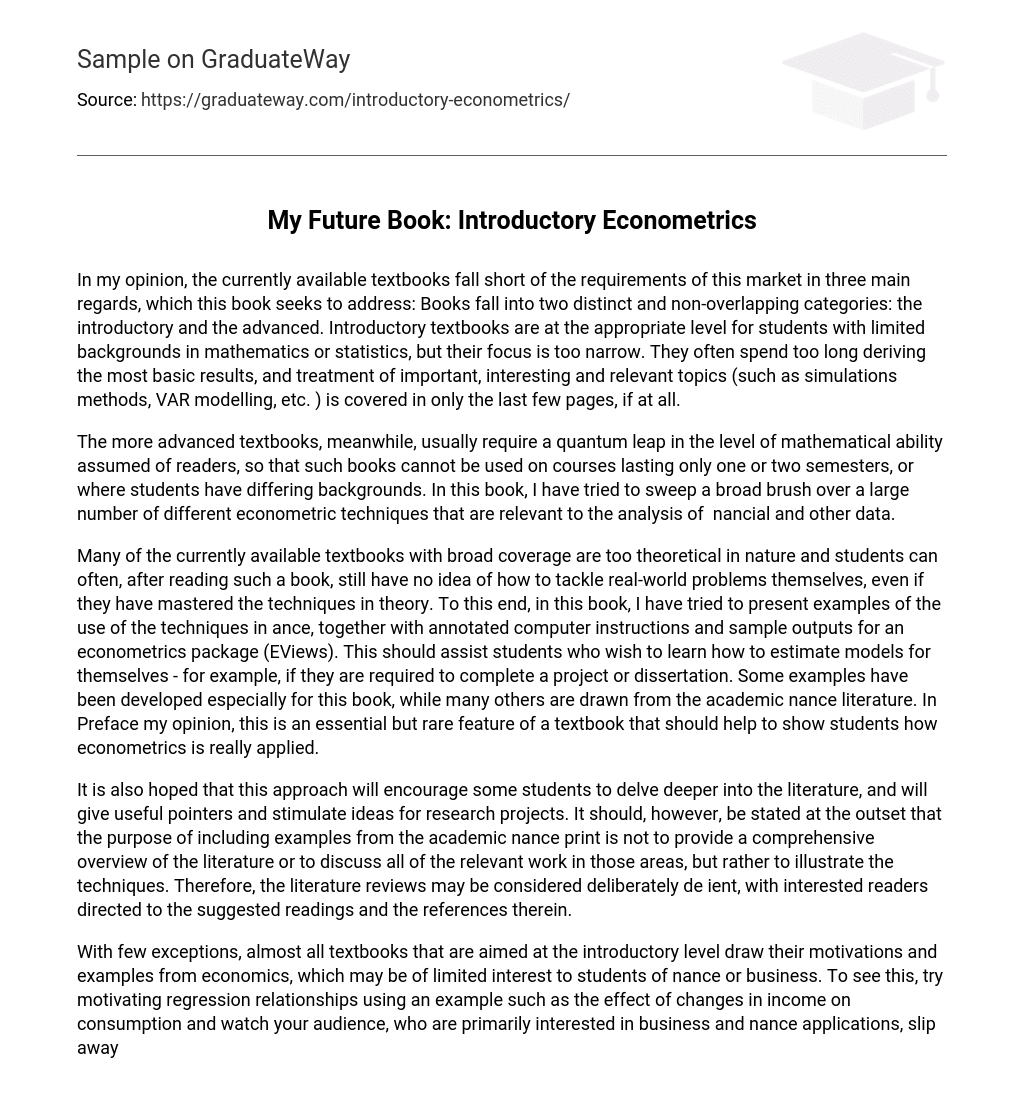In my opinion, the currently available textbooks fall short of the requirements of this market in three main regards, which this book seeks to address: Books fall into two distinct and non-overlapping categories: the introductory and the advanced. Introductory textbooks are at the appropriate level for students with limited backgrounds in mathematics or statistics, but their focus is too narrow. They often spend too long deriving the most basic results, and treatment of important, interesting and relevant topics (such as simulations methods, VAR modelling, etc. ) is covered in only the last few pages, if at all.
The more advanced textbooks, meanwhile, usually require a quantum leap in the level of mathematical ability assumed of readers, so that such books cannot be used on courses lasting only one or two semesters, or where students have differing backgrounds. In this book, I have tried to sweep a broad brush over a large number of different econometric techniques that are relevant to the analysis of nancial and other data.
Many of the currently available textbooks with broad coverage are too theoretical in nature and students can often, after reading such a book, still have no idea of how to tackle real-world problems themselves, even if they have mastered the techniques in theory. To this end, in this book, I have tried to present examples of the use of the techniques in ance, together with annotated computer instructions and sample outputs for an econometrics package (EViews). This should assist students who wish to learn how to estimate models for themselves – for example, if they are required to complete a project or dissertation. Some examples have been developed especially for this book, while many others are drawn from the academic nance literature. In Preface my opinion, this is an essential but rare feature of a textbook that should help to show students how econometrics is really applied.
It is also hoped that this approach will encourage some students to delve deeper into the literature, and will give useful pointers and stimulate ideas for research projects. It should, however, be stated at the outset that the purpose of including examples from the academic nance print is not to provide a comprehensive overview of the literature or to discuss all of the relevant work in those areas, but rather to illustrate the techniques. Therefore, the literature reviews may be considered deliberately de ient, with interested readers directed to the suggested readings and the references therein.
With few exceptions, almost all textbooks that are aimed at the introductory level draw their motivations and examples from economics, which may be of limited interest to students of nance or business. To see this, try motivating regression relationships using an example such as the effect of changes in income on consumption and watch your audience, who are primarily interested in business and nance applications, slip away and lose interest in the rst ten minutes of your course.
Who should read this book? The intended audience is undergraduates or Masters/MBA students who require a broad knowledge of modern econometric techniques commonly employed in the nance literature. It is hoped that the book will also be useful for researchers (both academics and practitioners), who require an introduction to the statistical tools commonly employed in the area of nance. The book can be used for courses covering nancial time-series analysis or nancial econometrics in undergraduate or postgraduate programmes in nance, nancial economics, securities and investments.
Although the applications and motivations for model-building given in the book are drawn from nance, the empirical testing of theories in many other disciplines, such as management studies, business studies, real estate, economics and so on, may usefully employ econometric analysis. For this group, the book may also prove useful. Finally, while the present text is designed mainly for students at the undergraduate or Masters level, it could also provide introductory reading in nancial time-series modelling for nance doctoral programmes where students have backgrounds which do not include courses in modern econometric techniques.
Pre-requisites for good understanding of this material In order to make the book as accessible as possible, the only background recommended in terms of quantitative techniques is that readers have introductory knowledge of calculus, algebra (including matrices) and basic statistics. However, even these are not necessarily prerequisites since they are covered brie y in an appendix to the text. The emphasis throughout the book is on a valid application of the techniques to real data and problems in nance.
In the nance and investment area, it is assumed that the reader has knowledge of the fundamentals of corporate ance, nancial markets and investment. Therefore, subjects such as portfolio theory, the Capital Asset Pricing Model (CAPM) and Arbitrage Pricing Theory (APT), the ef cient markets hypothesis, the pricing of derivative securities and the term structure of interest rates, which are frequently referred to throughout the book, are not treated in this text. There are very many good books available in corporate nance, in investments, and in futures and options, including those by Brealey and Myers (2005), Bodie, Kane and Marcus (2008) and Hull (2005) respectively.
I am grateful to Gita Persand, Olan Henry, James Chong and Apostolos Katsaris, who assisted with various parts of the software applications for the rst edition. I would also like to thank Simon Burke, James Chong and Con Keating for detailed and constructive comments on various drafts of the rst edition and Simon Burke for comments on parts of the second edition.





